They are known as hummingbirds because of the humming sound created by their beating wings which flap at high frequencies audible to humans. They hover in mid-air at rapid wing-flapping rates, typically around 50 times per second, allowing them also to fly at speeds exceeding 15 m/s (54 km/h; 34 mph),[1] backwards.[2]
Hummingbirds have the highest metabolism of any homeothermic animal.[3] To conserve energy when food is scarce, and nightly when not foraging, they go into torpor, a state similar to hibernation, slowing metabolic rate to 1/15th of its normal rate.[4]

Evolution
A map of the hummingbird family tree—reconstructed from analysis of 284 of the world's 338 known species—shows rapid diversification from 22 million years ago.[5] Hummingbirds fall into nine main clades, the Topazes, Hermits, Mangoes, Brilliants, Coquettes, Patagona, Mountain Gems, Bees, and Emeralds, defining their relationship to nectar-bearing flowering plants and the birds' continued spread into new geographic areas.[5][6][7][8]
While all hummingbirds depend on flower nectar to fuel their high
metabolisms and hovering flight, coordinated changes in flower- and bill
shape stimulated the formation of new species of hummingbirds and
plants. Due to this exceptional evolutionary pattern, as many as 140 hummingbird species can coexist in a specific region, such as the Andes Mountains.[5]The hummingbird evolutionary tree shows ancestral hummingbirds splitting from insectivorous swifts (family Apodidae) and treeswifts (family Hemiprocnidae) about 42 million years ago, probably in Eurasia.[5] One key evolutionary factor appears to be an altered taste receptor that enabled hummingbirds to seek nectar.[9] By 22 million years ago the ancestral species of current hummingbirds became established in South America, where environmental conditions stimulated further diversification.[5]
The Andes Mountains appear to be a particularly rich environment for hummingbird evolution because diversification occurred simultaneously with mountain uplift over the past 10 million years.[5] Hummingbirds remain in dynamic diversification inhabiting ecological regions across South America, North America, and the Caribbean, indicating an enlarging evolutionary radiation.[5]
Within the same geographic region, hummingbird clades co-evolved with nectar-bearing plant clades, affecting mechanisms of pollination.[10][11] The same is true for the sword-billed hummingbird (Ensifera ensifera), one of the morphologically most extreme species, and one of its main food plant clades (Passiflora section Tacsonia).[12]
Sexual dimorphisms
Hummingbirds exhibit sexual size dimorphism according to Rensch's rule,[13] in which males are smaller than females in small species, and males are larger than females in large-bodied species.[14] The extent of this sexual size difference varies among clades of hummingbirds.[14][15] For example, the Mellisugini clade exhibits a large size dimorphism, with females being larger than males.[15] Conversely, The Lophomithini clade displays very little size dimorphism; males and females are similar in size.[15] Sexual dimorphisms in beak size and shape are also present between male and female hummingbirds,[15] where in many clades, females have longer, more curved beaks favored for accessing nectar from tall flowers.[16] For males and females of the same size, females will tend to have larger beaks.[15]Sexual size and beak differences likely evolved due to constraints imposed by courtship because mating displays of male hummingbirds require complex aerial maneuvers and are costly in terms of energy.[13] Males tend to be smaller than females, allowing conservation of energy to forage competitively and participate more frequently in courtship.[13] Thus, sexual selection will favor smaller male hummingbirds.[13]
Female hummingbirds tend to be larger, requiring more energy, and their beaks longer to access preferred flowers.[15] Female hummingbirds tend to have longer beaks that allow for more effective reach into crevices of tall flowers for nectar.[16] Thus females are better at foraging, acquiring flower nectar, and supporting the energy demands of their larger body size.[16] Directional selection will thus favor the larger hummingbirds in terms of acquiring food.[14]
Another evolutionary cause of this sexual bill dimorphism is that the selective forces from competition for nectar between the sexes of each species are what drive the sexual dimorphism.[15] Depending on which sex holds territory in the species, it is advantageous for the other sex to have a longer bill and be able to feed on a wide variety of flowers, decreasing intraspecific competition.[16] For example, in species of hummingbirds where males have longer bills, males do not hold a specific territory and have a lek mating system.[16] In species where males have shorter bills than females, males defend their resources and therefore females must have a longer bill in order to feed from a broader range of flower.[16]
Co-evolution with ornithophilous flowers
Purple-throated carib feeding at a flower
Many plants pollinated by hummingbirds produce flowers in shades of red, orange, and bright pink, though the birds will take nectar from flowers of many colors. Hummingbirds can see wavelengths into the near-ultraviolet, but their flowers do not reflect these wavelengths as many insect-pollinated flowers do. This narrow color spectrum may render hummingbird-pollinated flowers relatively inconspicuous to most insects, thereby reducing nectar robbing.[18][19] Hummingbird-pollinated flowers also produce relatively weak nectar (averaging 25% sugars w/w) containing a high proportion of sucrose, whereas insect-pollinated flowers typically produce more concentrated nectars dominated by fructose and glucose.[20]
Possible beak evolution
Upon maturity, males of one species, Phaethornis longirostris, the long-billed hermit, appear to be evolving a dagger-like weapon on the beak tip as a secondary sexual trait to defend mating areas.[21]Systematics
A color plate illustration from Ernst Haeckel's Kunstformen der Natur (1899), showing a variety of hummingbirds
Between 325 and 340 species of hummingbirds are described, depending on taxonomic viewpoint, divided into two subfamilies, the hermits (subfamily Phaethornithinae, 34 species in six genera), and the typical hummingbirds (subfamily Trochilinae, all the others). However, recent phylogenetic analyses suggest that this division is slightly inaccurate, and that there are nine major clades of hummingbirds: the topazes and jacobins, the hermits, the mangoes, the coquettes, the brilliants, the giant hummingbird (Patagona gigas), the mountain-gems, the bees, and the emeralds.[23] The topazes and jacobins combined have the oldest split with the rest of the hummingbirds. The hummingbird family has the second-greatest number of species of any bird family (after the tyrant flycatchers).
Fossil hummingbirds are known from the Pleistocene of Brazil and the Bahamas; however, neither has yet been scientifically described, and fossils and subfossils of a few extant species are known. Until recently, older fossils had not been securely identifiable as those of hummingbirds.
In 2004, Dr Gerald Mayr of the Senckenberg Museum in Frankfurt am Main identified two 30-million-year-old hummingbird fossils.[24] The fossils of this primitive hummingbird species, named Eurotrochilus inexpectatus ("unexpected European hummingbird"), had been sitting in a museum drawer in Stuttgart; they had been unearthed in a clay pit at Wiesloch–Frauenweiler, south of Heidelberg, Germany, and because it was assumed that hummingbirds never occurred outside the Americas, were not recognized to be hummingbirds until Mayr took a closer look at them.
Fossils of birds not clearly assignable to either hummingbirds or a related, extinct family, the Jungornithidae, have been found at the Messel pit and in the Caucasus, dating from 40–35 mya; this indicates that the split between these two lineages indeed occurred at that date. The areas where these early fossils have been found had a climate quite similar to that of the northern Caribbean or southernmost China during that time. The biggest remaining mystery at the present time is what happened to hummingbirds in the roughly 25 million years between the primitive Eurotrochilus and the modern fossils. The astounding morphological adaptations, the decrease in size, and the dispersal to the Americas and extinction in Eurasia all occurred during this timespan. DNA-DNA hybridization results[25] suggest that the main radiation of South American hummingbirds took place at least partly in the Miocene, some 12 to 13 million years ago, during the uplifting of the northern Andes.
In 2013, a 50-million-year-old fossil bird unearthed in Wyoming was found to be a predecessor to both hummingbirds and swifts before the groups diverged.[26]
Lists of genera and species
- List of hummingbird genera
- List of hummingbird species, sortable alphabetically by common or binomial name
Specialized characteristics and metabolism
With the exception of insects, hummingbirds while in flight have the highest metabolism of all animals - a necessity to support the rapid beating of their wings during hovering and fast forward flight.[3][27] Their heart rate can reach as high as 1,260 beats per minute, a rate once measured in a blue-throated hummingbird,[28] with a breathing rate of 250 breaths per minute, even at rest.[29] During flight, oxygen consumption per gram of muscle tissue in a hummingbird is about 10 times higher than that measured in elite human athletes.[3]Hummingbirds consume more than their own weight in nectar each day, and to do so they must visit hundreds of flowers. Hummingbirds are continuously hours away from starving to death and are able to store just enough energy to survive overnight.[30]
Hummingbirds are rare among vertebrates in their ability to rapidly make use of ingested sugars to fuel energetically expensive hovering flight, powering up to 100% of their metabolic needs with the sugars they drink (in comparison, human athletes max out at around 30%). Hummingbirds can use newly ingested sugars to fuel hovering flight within 30–45 minutes of consumption.[31][32] These data suggest that hummingbirds are able to oxidize sugar in flight muscles at rates high enough to satisfy their extreme metabolic demands. By relying on newly ingested sugars to fuel flight, hummingbirds can reserve their limited fat stores to sustain their overnight fasting or to power migratory flights.[31]
The dynamic range of metabolic rates in hummingbirds[33] requires a corresponding dynamic range in kidney function.[34] The glomerulus is a cluster of capillaries in each nephron of the kidney that removes certain substances from the blood, like a filtration mechanism. The rate at which blood is processed is called the glomerular filtration rate (GFR). Most often these fluids are reabsorbed by the kidneys. GFR also slows when a bird is undergoing water deprivation. The interruption of GFR is a survival and physiological mechanism unique to hummingbirds.[34]
Studies of hummingbirds' metabolisms are relevant to the question of how a migrating ruby-throated hummingbird can cross 800 km (500 mi) of the Gulf of Mexico on a nonstop flight.[29] This hummingbird, like other birds preparing to migrate, stores fat as a fuel reserve, thereby augmenting its weight by as much as 100%, hence increasing potential flying time over open water.[29][35]
Torpor
The metabolism of hummingbirds can slow at night or at any time when food is not readily available: the birds enter a hibernation-like, deep-sleep state (known as torpor) to prevent energy reserves from falling to a critical level. During night-time torpor, body temperature falls from 40 to 18 °C,[36] with heart and breathing rates both slowed dramatically (heart rate to roughly 50 to 180 beats per minute from its daytime rate of higher than 1000).[37]During torpor, to prevent dehydration, the GFR ceases, preserving needed compounds such as glucose, water, and nutrients.[34] Further, body mass declines throughout nocturnal torpor at a rate of 0.04 g per hour, amounting to about 10% of weight loss each night.[34] The circulating hormone, corticosterone, is one signal that arouses a hummingbird from torpor.[38]
Use and duration of torpor vary among hummingbird species and are affected by whether a dominant bird defends territory, with nonterritorial subordinate birds having longer periods of torpor.[39]
Lifespan
Hummingbirds have long lifespans for organisms with such rapid metabolisms. Though many die during their first year of life, especially in the vulnerable period between hatching and leaving the nest (fledging), those that survive may occasionally live a decade or more. Among the better-known North American species, the average lifespan is probably 3 to 5 years. (For comparison, the smaller shrews, among the smallest of all mammals, seldom live longer than 2 years.[40]) The longest recorded lifespan in the wild relates to a female broad-tailed hummingbird that was banded (ringed) as an adult at least one year old, then recaptured 11 years later, making her at least 12 years old. Other longevity records for banded hummingbirds include an estimated minimum age of 10 years 1 month for a female black-chinned hummingbird similar in size to the broad-tailed hummingbird, and at least 11 years 2 months for a much larger buff-bellied hummingbird.[41]Reproduction
| This section needs additional citations for verification. (April 2015) (Learn how and when to remove this template message) |
Many hummingbird species use spider silk and lichen to bind the nest material together and secure the structure.[43][45] The unique properties of the silk allow the nest to expand as the young hummingbirds grow.[43][44] Two white eggs are laid,[43][45] which despite being the smallest of all bird eggs, are in fact large relative to the adult hummingbird's size.[44] Incubation lasts 14 to 23 days,[45] depending on the species, ambient temperature, and female attentiveness to the nest.[42] The mother feeds her nestlings on small arthropods and nectar by inserting her bill into the open mouth of a nestling, and then regurgitating the food into its crop.[42][44]
-
Incubating in Copiapó, Chile
-
nest with two nestlings in Santa Monica, California
-
feeding two nestlings in Grand Teton National Park
-
Fallen Anna's hummingbird nest in Ventura County, California, shown next to toothpick for scale
Feather colors
Male Anna's hummingbird showing iridescent crown and gorget feathers
By merely shifting position, feather regions of a muted-looking bird can instantly become fiery red or vivid green.[47] In courtship displays for one example, males of the colorful Anna's hummingbird orient their bodies and feathers toward the sun to enhance the display value of iridescent plumage toward a female of interest.[48]
One study of Anna's hummingbirds found that dietary protein was an influential factor in feather color, as birds receiving more protein grew significantly more colorful crown feathers than those fed a low-protein diet.[49] Additionally, birds on a high-protein diet grew yellower (higher hue) green tail feathers than birds on a low-protein diet.[49]
Aerodynamics of flight
A female ruby-throated hummingbird hovering in mid-air
A trail of wake vortices
generated by a hummingbird's flight discovered after training a bird to
fly through a cloud of neutrally buoyant, helium-filled soap bubbles
and recording airflows in the wake with stereo photography.[50]
Two studies of rufous or Anna's hummingbirds in a wind tunnel used particle image velocimetry techniques to investigate the lift generated on the bird's upstroke and downstroke.[51][52] The birds produced 75% of their weight support during the downstroke and 25% during the upstroke, with the wings making a "figure 8" motion.[53]
Many earlier studies had assumed that lift was generated equally during the two phases of the wingbeat cycle, as is the case of insects of a similar size.[51] This finding shows that hummingbird hovering is similar to, but distinct from, that of hovering insects such as the hawk moth.[51] Further studies using electromyography in hovering rufous hummingbirds showed that muscle strain in the pectoralis major (principal downstroke muscle) was the lowest yet recorded in a flying bird, and the primary upstroke muscle (supracoracoideus) is proportionately larger than in other bird species.[54] Hummingbird hovering has been estimated to be 20% more efficient than performed by a helicopter drone.[55]
Because of their flying technique, these birds no longer have an alula, while the alula digit has evolved to become absent.[56]
The giant hummingbird's wings beat as few as 12 beats per second[57] and the wings of typical hummingbirds beat up to 80 times per second.[55]
A slow-motion video has shown how the hummingbirds deal with rain when they are flying. To remove the water from their heads, they shake their heads and bodies, similar to a dog shaking, to shed water.[58] Further, when raindrops collectively may weigh as much as 38% of the bird's body weight, hummingbirds shift their bodies and tails horizontally, beat their wings faster, and reduce their wings' angle of motion when flying in heavy rain.[59]
Feather sonation
Courtship dives
The outer tail feathers of male Anna's (Calypte anna) and Selasphorus hummingbirds (e.g., Allen's, calliope) vibrate during courtship display dives and produce an audible chirp caused by aeroelastic flutter.[60][61] When courting, the male ascends some 35 meters before diving over an interested female at a speed of 27 m/s, equal to 385 body lengths/second, producing a high-pitched sound.[62] This downward acceleration during a dive is the highest reported for any vertebrate undergoing a voluntary aerial maneuver; in addition to acceleration, the speed, relative to body length, is the largest known for any vertebrate. For instance, it is about twice the diving speed of peregrine falcons in pursuit of prey.[62] At maximum descent speed, about 10 g of gravitational force occurs in the courting hummingbird during a dive.[62] By comparison to humans, this is a g-force acceleration causing near loss of consciousness in fighter pilots during flight of fixed-wing aircraft in a high-speed banked turn.[62][63]Hummingbirds can not make the courtship dive sound when missing their outer tail feathers, and those same feathers could produce the dive-sound in a wind tunnel.[60] The bird can sing at the same frequency as the tail feather chirp, but its small syrinx is not capable of the same volume.[64] The sound is caused by the aerodynamics of rapid air flow past tail feathers, causing them to flutter in a vibration which produces the high-pitched sound of a courtship dive.[60][65]
Many other species of hummingbirds also produce sounds with their wings or tails while flying, hovering or diving, including the wings of the calliope hummingbird,[66] broad-tailed hummingbird, rufous hummingbird, Allen's hummingbird, and streamertail, as well as the tail of the Costa's hummingbird and the black-chinned hummingbird, and a number of related species.[67] However, the harmonics of sounds during courtship dives vary across species of hummingbirds.[61]
Wing trill
Male rufous and broad-tailed hummingbirds (genus Selasphorus) have a distinctive wing feature during normal flight that sounds like jingling or a buzzing shrill whistle.[68] The trill arises from air rushing through slots created by the tapered tips of the ninth and tenth primary wing feathers, creating a sound loud enough to be detected by female or competitive male hummingbirds and researchers up to 100 m away.[68]Behaviorally, the whistle serves several purposes:[68]
- Announces the sex and presence of a male bird
- Provides audible aggressive defense of feeding territory and an intrusion tactic
- Enhances communication of threat
- Favors mate attraction and courtship
Range
See also: List of Apodiformes by population
Hummingbirds are restricted to the Americas from south central Alaska to Tierra del Fuego, including the Caribbean.
The majority of species occur in tropical and subtropical Central and
South America, but several species also breed in temperate climates and
some hillstars occur even in alpine Andean highlands at altitudes up to 5,200 metres (17,100 ft).[69]The greatest species richness is in humid tropical and subtropical forests of the northern Andes and adjacent foothills, but the number of species found in the Atlantic Forest, Central America or southern Mexico also far exceeds the number found in southern South America, the Caribbean islands, the United States, and Canada. While fewer than 25 different species of hummingbirds have been recorded from the United States and fewer than 10 from Canada and Chile each,[70] Colombia alone has more than 160[71] and the comparably small Ecuador has about 130 species.[72]
The migratory ruby-throated hummingbird breeds in a range from the southeastern United States to Ontario,[73] while the black-chinned hummingbird, its close relative and another migrant, is the most widespread and common species in the southwestern United States. The rufous hummingbird is the most widespread species in western North America.[74]
Migration
Most hummingbirds of the U.S. and Canada migrate southward in fall to spend winter in Mexico, the Caribbean Islands, or Central America. A few southern South American species also move north to the tropics during the southern winter. A few species are year-round residents of California and southwestern desert regions of the USA. Among these are Anna's hummingbird, a common resident from southern Arizona and inland California, and buff-bellied hummingbird, an uncommon resident in subtropical woodlands of southern Texas east through the Gulf coast to the Atlantic coast of Florida. Ruby-throated hummingbirds migrate from as far north as Ontario, Canada, in summer, returning to Mexico, South America, southern Texas, and Florida to winter.[75]The rufous hummingbird breeds farther north than any other species of hummingbird, often breeding in large numbers in temperate western North America and wintering in increasing numbers along the coasts of subtropical Gulf of Mexico and Florida, rather than in western or central Mexico.[76] By migrating in spring as far north as the Yukon or southern Alaska,[76] the rufous hummingbird migrates more extensively and nests farther north than any other hummingbird species, and must tolerate occasional temperatures below freezing in its breeding territory. This cold hardiness enables it to survive temperatures below freezing, provided that adequate shelter and food are available.
As calculated by displacement of body size, the rufous hummingbird makes perhaps the longest migratory journey of any bird in the world. At just over 3 in long, rufous birds travel 3,900-miles one-way from Alaska to Mexico in late summer, a distance equal to 78,470,000 body lengths.[76] By comparison, the 13-inch-long Arctic tern makes a one-way flight of about 11,185 miles, or 51,430,000 body lengths, just 65% of the body displacement during migration by rufous hummingbirds.[76]
The northward migration of rufous hummingbirds occurs along the Pacific flyway[76] and may be time-coordinated with flower and tree leaf emergence in spring in early March, and also with availability of insects as food.[77] Arrival at breeding grounds before nectar availability from mature flowers may jeopardize breeding opportunities, a factor of phenology possibly determining future migratory patterns linked to climate change.[78]
Diet and specializations for food gathering
Green violetear at a flower
Hummingbird in Copiapó, Chile: The apparent slow movement of its wings is a result of the stroboscopic effect.
Hummingbirds do not spend all day flying, as the energy cost would be prohibitive; the majority of their activity consists simply of sitting or perching. Hummingbirds eat many small meals and consume around half their weight in pure sugar (twice their weight in nectar, if the nectar is 25% sugar) each day.[81] Hummingbirds digest their food rapidly due to their small size and high metabolism; a mean retention time less than an hour has been reported.[82] Hummingbirds spend an average of 10–15% of their time feeding and 75–80% sitting and digesting.
Because they starve so easily, hummingbirds are highly attuned to food sources. Some species, including many found in North America, are territorial and will try to guard food sources (such as a feeder) against other hummingbirds, attempting to ensure a future food supply for itself.
Hummingbird bill shapes vary dramatically, as an adaptation for specialized feeding. Some species, such as hermits (Phaethornis spp.) have long bills that allow them to probe deep into flowers with long corollae. Thornbills have short, sharp bills adapted for feeding from flowers with short corollae and piercing the bases of longer ones. The sicklebills' extremely decurved bills are adapted to extracting nectar from the curved corollae of flowers in the family Gesneriaceae. The bill of the fiery-tailed awlbill has an upturned tip, as in the avocets. The male tooth-billed hummingbird has barracuda-like spikes at the tip of its long, straight bill.
The two halves of a hummingbird's bill have a pronounced overlap, with the lower half (mandible) fitting tightly inside the upper half (maxilla). When a hummingbird feeds on nectar, the bill is usually opened only slightly, allowing the tongue to dart out and into the interior of flowers. Hummingbird bill sizes range from about 5 mm to as long as 100 mm (about 4 in).[83] When catching insects in flight, a hummingbird's jaw flexes downward to widen the gape for successful capture.[80]
Tongue as a micropump
Hummingbirds drink with their tongues by rapidly lapping nectar. Their tongues have tubes which run down their lengths and help the hummingbirds drink the nectar.[84] While capillary action was believed to be what drew nectar into these tubes, high-speed photography has revealed that the tubes open down their sides as the tongue goes into the nectar, and then close around the nectar, trapping it so it can be pulled back into the beak.[85][86] The tongue, which is forked, is compressed until it reaches nectar, then the tongue springs open, the rapid action traps the nectar and the nectar moves up the grooves, like a pump action, with capillary action not involved.[84][87] Consequently, tongue flexibility enables accessing, transporting and unloading nectar.[88][89]Feeders and artificial nectar
Hummingbirds will either hover or perch to feed; red feeders are preferred, but colored liquid is not necessary.
White granulated sugar is the best sweetener to use in hummingbird feeders. A ratio of 1 part sugar to 4 parts water is a common recipe,[92] although hummingbirds will defend feeders more aggressively when sugar content is at 35%, indicating preference for nectar with higher sweetness and sugar content.[93] Boiling and then cooling this mixture before use has been recommended to help deter the growth of bacteria and fungi. Brown, turbinado, and "raw" sugars contain iron, which can be deadly to hummingbirds if consumed over long periods.[94] Honey is made by bees from the nectar of flowers, but it is not good to use in feeders because when it is diluted with water, microorganisms easily grow in it, causing it to spoil rapidly.[95][96][97]
Hummingbirds hovering at an artificial nectar feeder
Other animals also visit hummingbird feeders. Bees, wasps, and ants are attracted to the sugar-water and may crawl into the feeder, where they may become trapped and drown. Orioles, woodpeckers, bananaquits, and other larger animals are known to drink from hummingbird feeders, sometimes tipping them and draining the liquid.[99] In the southwestern United States, two species of nectar-drinking bats (Leptonycteris yerbabuenae and Choeronycteris mexicana) visit hummingbird feeders to supplement their natural diet of nectar and pollen from saguaro cacti and agaves.[100]
Superficially similar birds
Some species of sunbirds of Africa, southern and southeastern Asia, and Australia resemble hummingbirds in appearance and behavior, as do perhaps also the honeyeaters of Australia and Pacific islands. These two groups, however, are not related to hummingbirds, as their resemblance is due to convergent evolution.[101]The hummingbird moth is often mistaken for a hummingbird.
In myth and culture
Aerial photograph of hummingbird image as part of Nazca Lines in Peru
- Aztecs wore hummingbird talismans, the talismans being representations as well as actual hummingbird fetishes formed from parts of real hummingbirds: emblematic for their vigor, energy, and propensity to do work along with their sharp beaks that mimic instruments of weaponry, bloodletting, penetration, and intimacy. Hummingbird talismans were prized as drawing sexual potency, energy, vigor, and skill at arms and warfare to the wearer.[102]
- The Aztec god of war Huitzilopochtli is often depicted as a hummingbird (right). It was also believed that fallen warriors would return to earth as hummingbirds and butterflies.[103] The Nahuatl word huitzil (hummingbird) is an onomatopoeic word derived from the sounds of the hummingbird's wing-beats and zooming flight.
- One of the Nazca Lines depicts a hummingbird (right).
- Trinidad and Tobago, known as "The land of the hummingbird," displays a hummingbird on that nation's coat of arms,[104] 1-cent coin[105] and emblem of its national airline, Caribbean Airlines (right).
Hummingbird as part of the emblem for Caribbean Airlines
Gallery
-
Hummingbird feeding from a flower in the University of California Botanical Garden
-
Hummingbird attacking larger song sparrow
-
Hummingbird and honey bee sizes compared

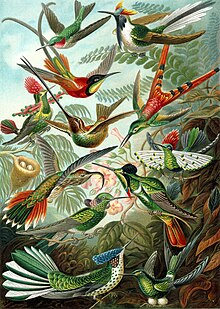




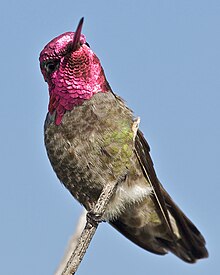


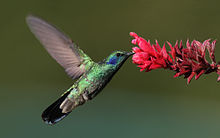









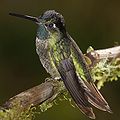

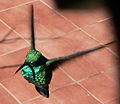










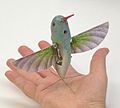
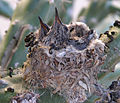


No comments:
Post a Comment
Note: Only a member of this blog may post a comment.